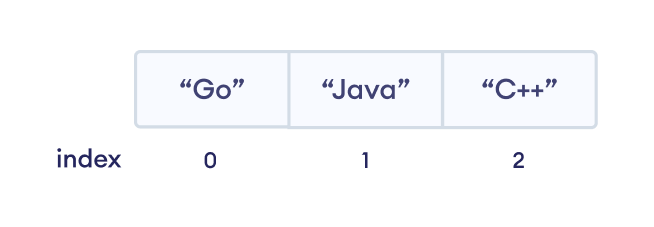Slice 是一种包含相似数据类型的集合,就像数组一样。
然而,与数组不同的是,slice 没有固定的大小。我们可以从数组中添加或删除元素。
在 Golang 中创建 Slice
以下是在 Golang 中创建 slice 的方法
numbers := []int{1, 2, 3, 4, 5}这里,
numbers- slice 的名称int- 表示 slice 只包含整数{1, 2, 3, 4, 5}- slice 的元素
您可能已经注意到,我们留空了 [] 符号。这是因为我们可以向 slice 添加元素,这将改变其大小。
注意:如果我们为 [] 符号提供大小,它将变成一个数组。例如,
// this is an array
numbers := [5]int{1, 2, 3, 4, 5}
// this is a slice
numbers := []int{1, 2, 3, 4, 5}Golang Slice 示例
// Program to create a slice and print its elements
package main
import "fmt"
func main() {
// declare slice variable of type integer
numbers := []int{1, 2, 3, 4, 5}
// print the slice
fmt.Println("Numbers: ", numbers)
}输出
Numbers: [1 2 3 4 5]
在上面的示例中,我们创建了一个名为 numbers 的 slice。在这里,int 指定 numbers slice 只能存储整数。
注意:我们也可以使用 var 关键字来创建 slice。例如,
var numbers = []int{1, 2, 3, 4}从 Golang 数组创建 Slice
在 Go 编程中,我们也可以从现有数组创建 slice。例如,
假设我们有一个数字数组
numbers := [8]int{10, 20, 30, 40, 50, 60, 70, 80}现在,我们可以从这个数组中切片指定的元素来创建一个新的 slice。
sliceNumbers = numbers[4, 7]这里,
- 4 是我们从中切片数组元素的起始索引
- 7 是我们想要获取数组元素结束的索引
从数组创建 slice 时,起始索引是包含在内的,而结束索引是不包含在内的。因此,我们的 slice 将包含元素 [50, 60, 70]。
示例:在 Go 中从数组创建 Slice
// Program to create a slice from an array
package main
import "fmt"
func main() {
// an integer array
numbers := [8]int{10, 20, 30, 40, 50, 60, 70, 80}
// create slice from an array
sliceNumbers := numbers[4 : 7]
fmt.Println(sliceNumbers)
}输出
[50, 60, 70]
Slice 函数
在 Go 中,slice 提供了各种内置函数,允许我们对 slice 执行不同的操作。
| 函数 | 描述 |
|---|---|
append() |
向 slice 添加元素 |
copy() |
将一个 slice 的元素复制到另一个 slice |
Equal() |
比较两个 slice |
len() |
查找 slice 的长度 |
向 Slice 添加元素
我们使用 append() 函数向 slice 添加元素。例如,
// Program to add elements to a slice
package main
import "fmt"
func main() {
primeNumbers := []int{2, 3}
// add elements 5, 7 to the slice
primeNumbers = append(primeNumbers, 5, 7)
fmt.Println("Prime Numbers:", primeNumbers)
}输出
Prime Numbers: [2 3 5 7]
在这里,代码
primeNumbers = append(primeNumbers, 5, 7)将元素 5 和 7 添加到 primeNumbers。
我们也可以使用 append() 函数将一个 slice 的所有元素添加到另一个 slice。例如,
// Program to add elements of one slice to another
package main
import "fmt"
func main() {
// create two slices
evenNumbers := []int{2, 4}
oddNumbers := []int{1, 3}
// add elements of oddNumbers to evenNumbers
evenNumbers = append(evenNumbers, oddNumbers...)
fmt.Println("Numbers:", evenNumbers)
}输出
Numbers: [2 4 1 3]
在这里,我们使用 append() 将 oddNumbers 的元素添加到 evenNumbers 元素的列表中。
复制 Golang Slice
我们可以使用 copy() 函数将一个 slice 的元素复制到另一个 slice。例如,
// Program to copy one slice to another
package main
import "fmt"
func main() {
// create two slices
primeNumbers := []int{2, 3, 5, 7}
numbers := []int{1, 2, 3}
// copy elements of primeNumbers to numbers
copy(numbers, primeNumbers)
// print numbers
fmt.Println("Numbers:", numbers)
}输出
Numbers: [2 3 5]
在上面的示例中,我们将 primeNumbers 的元素复制到 numbers。
copy(numbers, primeNumbers)在这里,只有 primeNumbers 的前 3 个元素被复制到 numbers。这是因为 numbers 的大小是 3,它只能容纳 3 个元素。
copy() 函数会用元素替换目标数组的所有元素。
查找 Slice 的长度
我们使用 len() 函数来查找 slice 中存在的元素数量。例如,
// Program to find the length of a slice
package main
import "fmt"
func main() {
// create a slice of numbers
numbers := []int{1, 5, 8, 0, 3}
// find the length of the slice
length := len(numbers)
fmt.Println("Length:", numbers)
}输出
Length: 5
遍历 Go Slice
在 Go 中,我们可以使用 for 循环来遍历 slice。例如,
// Program that loops over a slice using for loop
package main
import "fmt"
func main() {
numbers := []int{2, 4, 6, 8, 10}
// for loop that iterates through the slice
for i := 0; i < len(numbers); i++ {
fmt.Println(numbers[i])
}
}输出
2 4 6 8 10
在这里,len() 函数返回 slice 的大小。slice numbers 的大小是 5,所以 for 循环会迭代 5 次。
常见问题
在 Go 中,slice 中的每个元素都与一个数字相关联。这个数字称为 slice 索引。
我们可以使用索引号 (0, 1, 2 …) 来访问 slice 的元素。例如,
// Program to access the slice elements
package main
import "fmt"
func main() {
languages := []string{"Go", "Java", "C++"}
// access element at index 0
fmt.Println(languages[0])
// access element at index 2
fmt.Println(languages[2])
// access elements from index 0 to index 2
fmt.Println(languages[0:3])
}输出
Go C++ [Go Java C++]
在上面的示例中,我们创建了一个名为 languages 的 slice。

在这里,我们可以看到每个 slice 元素都与索引号相关联。而且,我们使用了索引号来访问元素。
注意:slice 索引总是从 0 开始。因此,slice 的第一个元素位于索引 0,而不是 1。
我们可以使用相同的索引号来更改 slice 元素的值。例如,
package main
import "fmt"
func main() {
weather := []string{"Rainy", "Sunny", "Cloudy"}
//change the element of index 2
weather[2] = "Stromy"
fmt.Println(weather)
}输出
[Rainy Sunny Stromy]
在这里,索引 2 的值从 "Cloudy" 更改为 "Stromy"。
在 Go 中,我们也可以使用 make() 函数来创建 slice。例如,
numbers := make([]int, 5, 7)在这里,我们创建了一个整数类型的 slice。
- 5 是 slice 的长度(slice 中元素的数量)
- 7 是 slice 的容量(slice 可以扩展到的最大大小)
让我们看一个例子,
package main
import "fmt"
func main() {
// create a slice using make()
numbers := make([]int, 5, 7)
// add elements to numbers
numbers[0] = 13
numbers[1] = 23
numbers[2] = 33
fmt.Println("Numbers:", numbers)
}输出
Numbers: [13 23 33 0 0]
在这里,我们创建了长度为 5 的 slice。但是,我们只初始化了 3 个值到 slice。
在这种情况下,剩余的值被初始化为默认值 0。
除了使用 for 循环,我们还可以使用 for range 来遍历 Golang 中的 slice。例如,
// Program that loops over a slice using for range loop
package main
import "fmt"
func main() {
numbers := []int{2, 4, 6, 8, 10}
// for range loop that iterates through a slice
for _, value := range numbers {
fmt.Println(value)
}
}输出
2 4 6 8 10
在这里,for range 循环遍历 slice 的第一个元素 (2) 到最后一个元素 (10)。要了解 range,请访问 Go range。